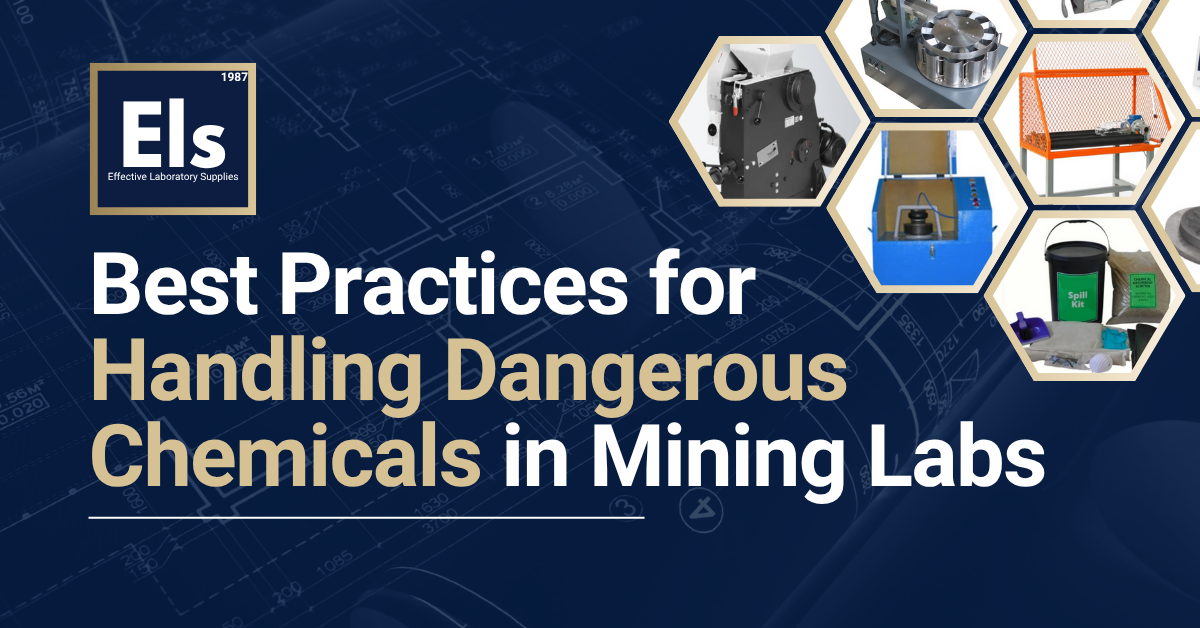Blog
Best Practices for Handling Dangerous Chemicals in Mining Labs

When you’re running a mining laboratory, handling dangerous chemicals is part of the job—but familiar doesn’t mean risk-free. Let’s examine the facts: mining labs handle some of the most aggressive chemicals in analytical work, from concentrated acids to volatile solvents, often under pressure to deliver rapid results.
Competent handling of hazardous materials is crucial for protecting your staff, ensuring your lab runs smoothly, and avoiding costly shutdowns. Compliance with Safety, Health, Environment, and Quality (SHEQ) standards supports these outcomes, but day-to-day safety practices matter most.
Here’s what you need to know about building a safety-first culture that protects your team while maintaining compliance and operational efficiency.
What Makes a Mining Lab Inherently Dangerous
Mining laboratories face unique challenges that amplify the risks associated with chemicals. You’re dealing with acids, oxidisers, flammables, and heavy metal residues on a daily basis. Often, in high volumes and sometimes in harsh field environments.
The three primary concerns are:
- Chemical exposure (including burns and skin contact with corrosive substances)
- Fire hazards
- Inhalation risks
It’s no secret that mining laboratories also operate under time pressure with multiple sample batches. This combination of dangerous materials and fast-paced workflows creates scenarios where even minor safety lapses can escalate quickly.
Building Safety Into Your Lab’s DNA
A safety-first lab isn’t built on documents alone. Safety must be built into every workflow, space, and habit. Everyone, from operators to managers, must understand what to do and why these procedures are important.
Laboratory layout, signage, storage zones, and Personal Protective Equipment (PPE) are just as critical as your Standard Operating Procedures (SOPs). When safety becomes second nature rather than an afterthought, you’ll notice fewer incidents and more confident staff performance.
Correct Chemical Storage: Non-Negotiable Principles
Chemical segregation is where most labs either excel or fail spectacularly.
Poor segregation remains one of the most common causes of preventable laboratory accidents. Always store chemicals by compatibility groups, with acids separated from bases, and flammables separated from oxidisers. Never compromise on this.
A compliant storage system should incorporate:
- Properly ventilated, fire-rated cabinets for each chemical class.
- Clear labelling and hazard identification.
- Restricted access control for trained staff only.
- Strategic placement of PPE at points of use, not scattered across the lab.
Fire-rated chemical storage cabinets and designated storage rooms aren’t luxuries, but fundamental to protecting your team and your equipment investments.
Smart Design Principles for Handling Dangerous Chemicals Safely
Safe chemical handling begins with intelligent lab design. Even small or containerised labs can meet compliance standards when designed with intention rather than convenience.
Key safety design elements include:
- Use ventilated balance enclosures or fume hoods when weighing volatile or hazardous chemicals to control exposure.
- Install downdraught benches connected to dust extraction systems in sample preparation areas to manage dust and fine particles safely.
- Dedicated fume extraction in all wet chemistry zones.
- Physically separate wet and dry work areas to avoid cross-contamination.
- Position emergency equipment (e.g. eyewash stations, extinguishers) within easy reach.
Understanding these design concepts will enable you to create spaces where safe behaviour becomes the natural choice rather than an additional burden.
Equipment That Transforms Lab Safety
At ELS, we’ve seen how the right equipment transforms laboratory safety from a daily concern into a reliable foundation. Our comprehensive safety solutions include fire-rated chemical storage cabinets, specialised spill kits for acids and solvents, downdraught workbenches, and integrated fume extraction units.
To reduce exposure risks, consider enclosed equipment where possible, such as:
- Rotary Sample Dividers (RSDs) fitted with dust hoods, and
- Equipment fitted with safety features, including
- Leach bottle rollers in safety cages
- Pulverisers and crushers (equipped with emergency safety switches or safety interlocks).
Digital Tools for Modern Safety Management
Technology is changing how we manage the risks associated with handling dangerous chemicals.
We include a product information sheet with every quote, which contains direct links to the relevant Material Safety Data Sheets (MSDS) hosted on our website. This provides you with quick access to safety information for the specified chemical. Additionally, it reduces emergency response time and improves compliance and audit readiness.
We can provide training support and chemical zoning advice, along with our equipment, as well as assistance with spill response planning and SOP development.
You might be wondering why we go beyond simple equipment supply? That’s because effective safety requires understanding the complete system, not just individual components.
Looking Ahead at Laboratory Safety
Exciting developments in safety technology are underway. QR codes and Internet of Things (IoT)-enabled safety equipment are becoming standard. As is Artificial Intelligence (AI)-driven layout optimisation, which helps design safer, more efficient lab spaces.
Modular laboratories with built-in zoning and automation represent the future of mining lab design, integrating safety upfront (rather than retrofitting). This approach reduces costs while improving safety outcomes and operational efficiency.
Practical Steps Towards Safety in Your Lab
Let’s work together to achieve measurable improvements in the safe handling of dangerous chemicals.
Begin with a systematic assessment of your current chemical storage and handling procedures. Focus on:
- Segregation
- Ventilation
- Emergency response capabilities
Building a safety-first culture includes creating an environment where people can perform at their best without unnecessary risks. Compliance, efficiency, and team confidence all improve when safety is “baked into” your operations.
If you’re looking for decades of laboratory expertise with practical solutions, ELS is ready to partner in transforming your mining lab’s safety infrastructure.

